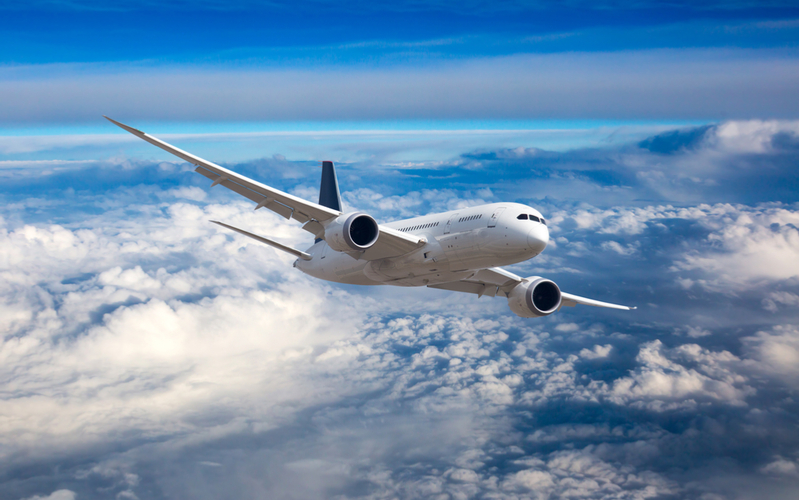The Glory and Majesty of the Dreamliner
The downside of the jetway is that it denies you the chance to appreciate the sheer awesomeness of the passenger jet. You walk from one room with chairs, shops, and restaurants, through an enclosed hallway, and enter into another room and sit down. So mundane. You can’t back away from the scene to appreciate the whole of what is happening. The experience of flying is reduced to looking out a small window.
That’s why I’m always thrilled when instead I can walk downstairs from the airport lobby and enter on to the tarmac. Then you climb the stairs to the plane, just like in the old movies. Every time, it lifts my heart. You can stand close to and finally board a thing of beauty. In my experience, this happens most often in airports in foreign countries.
It happened recently leaving the airport of Krakow, Poland, on my way back to Chicago. I stepped out of the airport and onto the tarmac. There it was before me, a sight that immediately struck me as one of the most awesome I had ever witnessed. The jet that would take me back to the US was of an incomprehensible size, a metal replication of the shape of a bird but on an enormous scale and made entirely by human hands.
I tried to think of anything in nature that could compare. I thought of huge animals on safaris, of glorious birds, or gigantic sea animals. I thought of huge mountains, great canyons, and terrifying bodies of water. Nothing compares. Then it dawned on me: humankind has created something truly astonishing here.
What’s more, it is not designed to serve a privileged caste but rather to carry average people to the other side of the world and back, soaring through the air while its passengers watch movies and drink wine.
When you think about life, life couldn’t be better. Where is the sense of awe? Where is the gratitude for the system that made such a thing come into existence?
The Dreamliner
The plane in question is the Boeing 787, also known as the Dreamliner. As the first airline with a body made of composite materials, it holds 335 passengers and is 20% more fuel-efficient than the 747. Its maiden voyage was in 2009 and now it is an essential tool for making the human population more mobile than ever before in history.
I stood there frozen with my mouth open, and watched the passengers climb aboard from two sides. I waited there for the last person to board, unwilling to give up even a moment in which I could somehow take in the awesome scene. Finally a flight attendant came up to me and said: “I know it is amazing but it is time for you to board now.”
I said to her: “What is it like for you to have a job on such a thing as this?”
She answered: “I’ve been on hundreds of flights, and truly, even now, I can’t understand how flight is even possible, much less how this thing carries hundreds of people to the other side of the world, much less how this thing comes to exist in the first place. I’m just along for the ride.”
Aren’t we all along for the ride? She doesn’t understand it and I don’t understand it either. You know who else doesn’t understand it? Just about everyone else working in and around the plane to guide its motion, load the bags, cater the meals on board, and even those who fly the planes.
The mechanics don’t fully understand all its operations. The engineers, specialists in one small aspect of its functioning, don’t have the cognitive wherewithal to process the whole. The people who sell the tickets don’t understand it. The employees in air traffic control don’t understand it. Not even the people who make this machine can possibly understand the whole much less recreate such a thing. It is a marvelous example of the immensely productive capacity of the human mind working in cooperation with others.
Where Was This Made?
I looked up the plane to see where it is made. It is assembled in Everett, Washington. But that means almost nothing. Look at the rest of what’s behind this.
The wings are manufactured by Mitsubishi in Japan. The horizontal stabilizers are made by Alenia Aeronautica in Italy and Korea Aerospace in South Korea. The fuselage sections are made in Italy, Charleston, South Carolina, by Kawasaki in Japan, by Spirit AeroSystems in Witchita, Kansas, and Korean Air in South Korea.
The passenger doors are made by Latecoere in France. The cargo doors, access doors, and crew doors are made in Sweden. The software that runs the plane is programmed by HCL Enterprise in India. The floor beams also come from India.
The wiring is from Labinal in France. The wing tips, support fairs, and wheel parts are from South Korea. The landing gear is manufactured by Messier-Bugatti-Dowty in France and the UK. The power and management systems and air conditioning come from Connecticut.
And that doesn’t even get us to the blankets, food, and drinks for the passengers, the glass on the windows, the carpet on the floor, the music and movies on the screens in front of each chair, plus the tools that made all these things and the tools that made the tools. If it were even possible to add it all up, there would be a hundred nations, thousands of communities, and multiples of millions of people who cooperate together to cause this thing to exist.
What a marvel!
Who Did It?
You have entrepreneurs, dreamers, and capitalists who might have imagined such a thing. But in truth, no one person can contain the whole, much less realize the vision. The genius visionary is not entirely a myth but this institution of the singular great man has been greatly exaggerated. They have always and everywhere depended on others to realize it.
They, in turn, depend on others, and more and more, in widening circles of specialization and expertise, involving ever more people. Their expertise is also dependent on the technological capital built up over time, going back centuries, to realize what we call human progress. Even then, it is not enough to have an idea; every idea that comes to fruition must depend on saved capital – real resources – to deploy on a risk.
And what is that risk? The risk is that customer won’t finally show up to commit real resources to make the project pass the ultimate test, which is profit and loss. Accounting is the economic brick wall that every enterprising dreamer must confront. It works or it does not. And the only final determining factor is whether the consumer is willing to forgo his or her own property to buy your product.
Big and Small
The sheer scale of the 787 itself makes the point. Our lizard brains are impressed. But what about the smaller things around us? I could cite the obvious: the smartphone that has more computing power than the rockets that landed on the moon. It provides access to most all human knowledge, from inside our pockets! It is a marvel.
But let’s consider something even more mundane, something like the paperclip. You can’t remember ever saving one. It is not valuable enough; each costs less than a penny. But a similar process is involved in making one of those tiny things. If you doubt it, just think through what it would be like to make one yourself. You could never do it, much less achieve it and make your money back.
And yet through the process of human cooperation, the paper clip comes to be. So does the Dreamliner. And why? It’s all for you and me, regardless of our political views, gender identity, race, national origin, religion, or any other category that politics uses to exploit our differences rather than bring us together.
Markets are the key to prosperity and progress. We are surrounded by the evidence, provided we are willing to pay attention. It’s sad that it takes something as breathtaking as the Dreamliner to jar our minds into realizing it.












